New features in Marigold Engage
August 22, 2024
Version 5.75
Segment Builder Option List Enhancements
BACKGROUND:
Previous improvements in the Segment builder for Option Lists allowed marketers to select values from a drop-down. However, there was no indication of how often these values are used, missing out on valuable information on the data available and audience segmentation.
SOLUTION:
Now, the number of records in which an option list value is used is indicated, providing marketers better insights on how their audiences are built.
What this looks like in Engage:
The option list drop-down now shows a count for each option list value, indicating how many times the value is used in the selected lists records:
Read-Only for Lists
BACKGROUND:
Previously, permissions for Lists allowed to give Access and Sharing rights to a user.
Access rights imply the right to create, manage lists, data, relations, segments, etc.
Sharing rights allow sharing lists with other organizations.
However, it was not possible to limit the rights to only view a list, allowing marketers to still use the list in a campaign, without the right to make any modifications.
SOLUTION:
A new read-only permission for Lists has been added, allowing users to use the list in a campaign, but without any rights to make modifications. This way you can avoid unwanted changes to lists, but still provide access.
When read-only is set for a list, opening the list allows the user to view it but all tabs and fields are disabled.
What this looks like in Engage:
In the Access Management tab of the Admin Configuration section of Engage, a new read-only permission for Lists is available.
When this option is switched on, Access and Sharing are switched off.
In the Lists chapter of Engage, opening a list shows a yellow read-only badge shown behind the list name together with a message “You don't have permission to edit lists”.
Furthermore, when accessing the list, all tabs and action buttons are disabled.
Engage Home Page - Storage Information in the Operational dashboard
BACKGROUND:
The Engage Home page with the Operational tab, provides valuable information on how marketing campaigns are doing, as well as insights on messages, contacts and journeys.
System storage information was missing on the Home page.
SOLUTION:
Storage details are now also included on the Home page.
What this looks like in Engage
A storage section shows the health status of your system on three levels : Database, disk and FTP usage.
Timezones for Recurring Batch Journeys and Scheduled Custom Events
BACKGROUND:
When setting up the scheduling for a Recurring or Single Batch Journey or configuring a scheduled event, no timezone information was displayed and the timezone applied to the scheduling options is by default the timezone of the user. However, this is not very clear when setting up the scheduling.
SOLUTION:
Now, a timezone can be configured when defining scheduling and activation options for a Recurring Batch Journey and setting up scheduled custom events. In addition, scheduling dates and times set for the journey are translated into the timezone of the user.
By default the user’s timezone is used for any new journey.
For existing journeys, the timezone is automatically set to the server timezone, in which these journeys have been saved previously.
What this looks like in Engage:
A new field is added to the scheduling and activation options of Recurring Batch Journeys and scheduled Custom Events.
By default, when creating a new journey, the timezone is set to the user’s timezone.
However, for journeys that existed prior to the implementation of the feature, the timezone is set to the server’s timezone.
Now, when the timezone is modified and is different from the user’s timezone, the information displayed on the activation start and end dates is automatically converted into the timezone of the user.
Example:
The time zone set for the journey activation and scheduling is UTC -8 (Pacific Standard Time).
The activation start date is set to 2024-08-13 02:00.
The activation end date is set to 2024-10-19 03:00.
The user’s timezone is set to UTC -5 (Eastern Standard Time).
This means that their local time has a 3 hour difference compared to the time zone set in the journey.
The user sees the following translated values:
- Start date: "In your timezone, Eastern Standard Time, the journey will start at 2024-08-13 05:00."
- End date: "In your timezone, Eastern Standard Time, the journey will end at 2024-10-19 06:00."
Corrections
- We added the capability of adding attachments to your messages, but these were lost in translation when working via templates and single batch journeys. We fixed this for you!
- A visibility constraint with 'isnotempty' will now correctly hide the content of the component
- Adding a lot of items in a Repeater through the instance designer of a Single Batch Journey no longer causes it to become unusable






